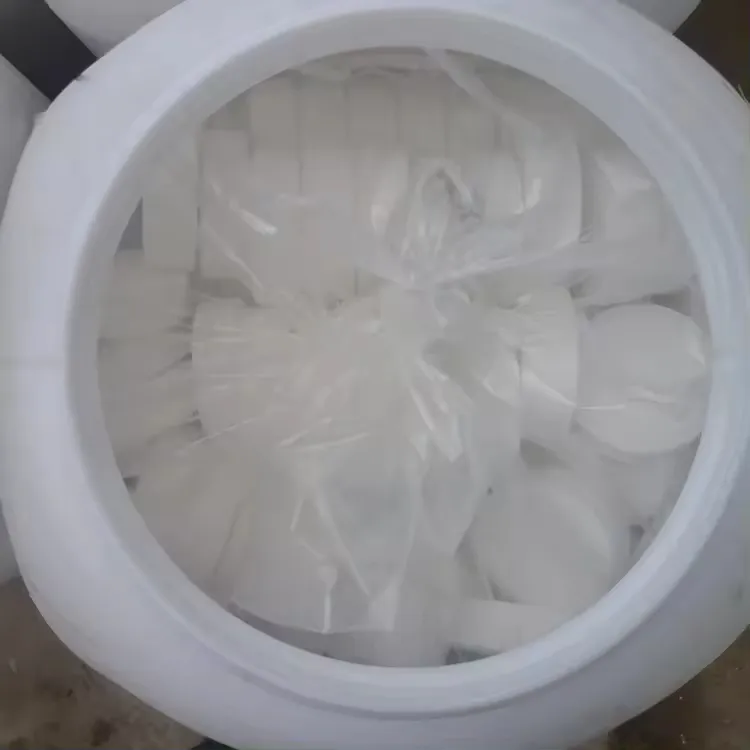



Understanding the Chemical Composition of Sodium Chlorite Formulation and Its Applications
Understanding Sodium Chlorite Composition, Uses, and Safety
Sodium chlorite is an inorganic compound with the formula NaClO₂. It is predominantly recognized for its role as a bleaching agent and as a precursor for producing chlorine dioxide, a powerful disinfectant. In this article, we will delve into the chemical structure of sodium chlorite, its applications, and important safety considerations associated with its use.
Chemical Structure
Sodium chlorite is composed of sodium ions (Na⁺) and chlorite ions (ClO₂⁻). The chlorite ion consists of one chlorine atom covalently bonded to two oxygen atoms, which are arranged in a bent configuration due to the presence of lone pairs on the chlorine atom. The chemical formula indicates that sodium chlorite has one sodium atom for every chlorite ion, resulting in a neutral compound overall.
The molecular weight of sodium chlorite is approximately 90.44 g/mol, and it is typically found as a white or yellowish powder. When dissolved in water, it forms a clear solution, which is utilized in a variety of industrial and health-related applications.
Industrial Applications
1. Bleaching Agent One of the most common uses of sodium chlorite is in the paper and textile industries as a bleaching agent. It is preferred over chlorine due to its lower environmental impact and ability to produce less harmful byproducts.
2. Water Treatment Sodium chlorite is widely used in municipal water treatment facilities where it is converted into chlorine dioxide. Chlorine dioxide is an effective disinfectant that is used to kill bacteria, viruses, and other pathogens in drinking water and wastewater. Its use has been shown to reduce the formation of harmful disinfection byproducts that are often associated with traditional chlorine methods.
3. Food Industry In the food industry, sodium chlorite is employed as an antimicrobial agent. It is utilized to sanitize food-processing equipment and improve food safety by reducing microbial counts.
formula for sodium chlorite

4. Textile and Paper Industries Apart from bleaching, sodium chlorite is used for the synthesis of various chemical intermediates in the production of dyes and other textile chemicals.
5. Oxidizing Agent in Chemical Synthesis Sodium chlorite serves as an oxidizing agent in various chemical reactions, paving the way for more complex synthetic processes in laboratories and manufacturing.
Health and Safety Considerations
While sodium chlorite has several beneficial applications, it is essential to handle it safely. Sodium chlorite is classified as a hazardous substance, and exposure can lead to irritation of the skin, eyes, and respiratory tract. It is crucial to utilize appropriate personal protective equipment (PPE) such as gloves, goggles, and masks when handling this compound.
Additionally, sodium chlorite should never be ingested in its concentrated form or mixed with acids, as this can produce chlorine gas, a highly toxic substance. Regulations and guidelines regarding the safe handling, storage, and disposal of sodium chlorite must always be adhered to, particularly in industrial settings.
Environmental Impact
The environmental impact of sodium chlorite is relatively manageable compared to some traditional chlorine compounds. However, the release of chlorite ions into the environment, especially in aquatic ecosystems, can be harmful to fish and other aquatic life. Therefore, it is vital to adhere to regulatory standards pertaining to its use and disposal to mitigate potential ecological risks.
Conclusion
In summary, sodium chlorite (NaClO₂) is a versatile chemical compound with important applications in various industries, particularly in bleaching and water treatment. While it offers numerous benefits as a disinfectant and oxidizing agent, it must be handled with care due to its hazardous nature. Understanding its chemical properties, applications, and safety measures is crucial for those working with or around this compound. As industries continue to seek effective and environmentally friendly solutions, sodium chlorite will undoubtedly remain a valuable component in many chemical processes.
-
Why Sodium Persulfate Is Everywhere NowNewsJul.07,2025
-
Why Polyacrylamide Is in High DemandNewsJul.07,2025
-
Understanding Paint Chemicals and Their ApplicationsNewsJul.07,2025
-
Smart Use Of Mining ChemicalsNewsJul.07,2025
-
Practical Uses of Potassium MonopersulfateNewsJul.07,2025
-
Agrochemicals In Real FarmingNewsJul.07,2025
-
Sodium Chlorite Hot UsesNewsJul.01,2025










